Leeds United have stumbled upon an unforeseen crisis. Their most pivotal player is Kalvin Phillips deployed as a deep-lying playmaker throughout this season. However, against Queens Park Rangers, a game that went completely out of Marcelo Bielsa’s grasp, Phillips picked up a red card in the dying minutes as a final nail to their coffin. What loomed ahead was a three-match suspension for Phillips and a lack of a suitable replacement with Adam Forshaw unavailable.
As Phillips went sliding recklessly into that late tackle, dragging with him Leeds United’s fears of letting an automatic promotion slip into jeopardy, a 19-year-old academy number six Alfie McCalmont watched on from the bench. McCalmont has impressed in the U23s with Carlos Corberán in the Professional Development League and is rumoured to be Phillips’ heir to the holding midfield position.
This scout report will attempt to break down McCalmont’s game, his strengths and weaknesses and examine whether he will be a reliable option through Phillips’ absence, even as a substitute. A tactical analysis will further look into how Leeds can look into preparing the teenager for the role in the long term.
Background
McCalmont is a Thorp Arch product, like fellow graduate Phillips. At around 170cm, he stands shorter than the latter but has caught eyes at Leeds United and the Northern Ireland youth and senior team with a similar set of skills. He was a major figure in Corberán’s campaign tactics last year in the PDL winning the youth league by beating Birmingham City in the final. A regular part of the Northern Ireland U19 and U21 teams, he was selected by the senior team in a friendly against Luxembourg in September. His senior debut for the national team makes him the only youth player in Corberán’s side to have played international football.
Aside from carrying Leeds DNA, he is a natural born holding midfielder and features regularly in that position for the Leeds United U23 side. His range of passing, vision, game intelligence and defensive attribute makes him a natural number six. He has also featured in different tactical systems, most commonly the 4-3-3, the 4-2-3-1 double pivot and the 3-4-3 with the U23 side. His performances have turned him into a star figure at Thorp Arch and the PDL, but is he ready for Elland Road?
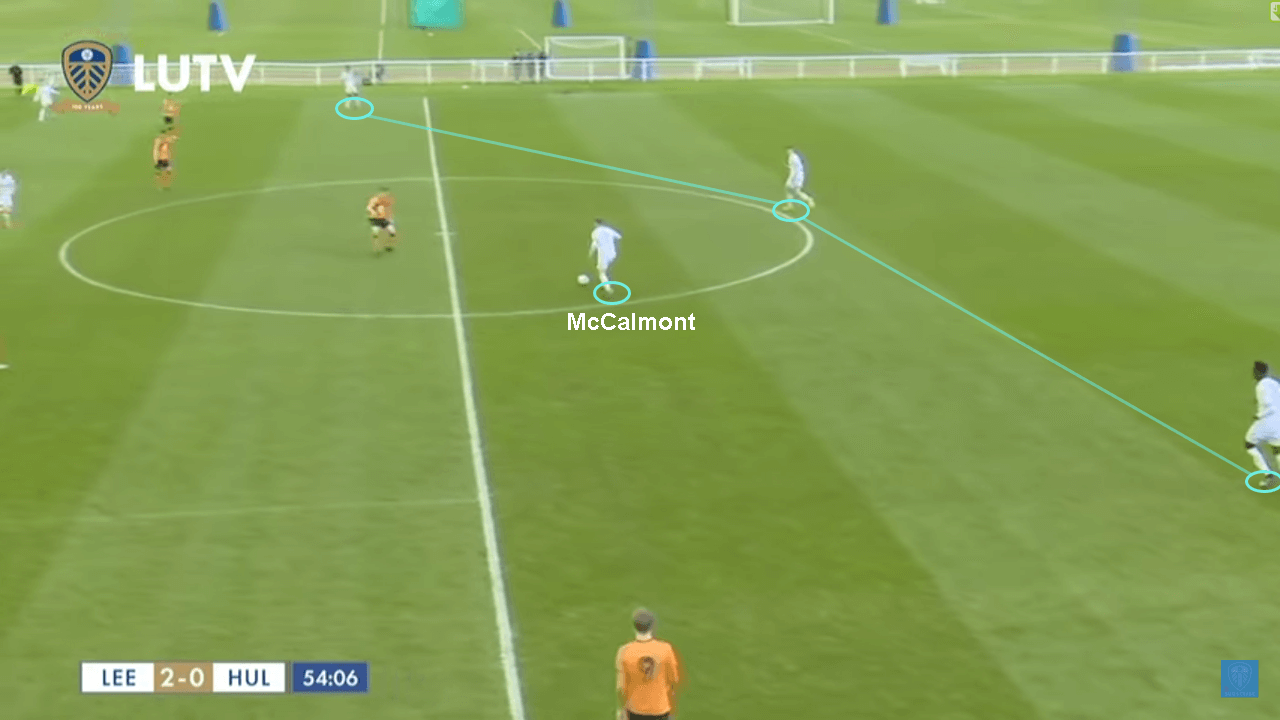
For this analysis, I have relied on statistical data collected from the international games he has featured in for the national team, and the two cup appearances he made with the Leeds United first team. I have also relied on tactical analysis of his youth league games in the PDL.
Actions on the ball
The potential weapon in his arsenal is his distribution with a good range, and he often looks for opportunities to hit the diagonal ball into wide pockets behind the opposition line of defence. He averages 5.8 long passes per 90 min, with a 63% accuracy. An impressive figure of 3.6 accurate long passes every 90 min shows why his long ball technique is on point. He also has close to a 100% accuracy on crosses despite having a lower total per game because of his deep-lying position.
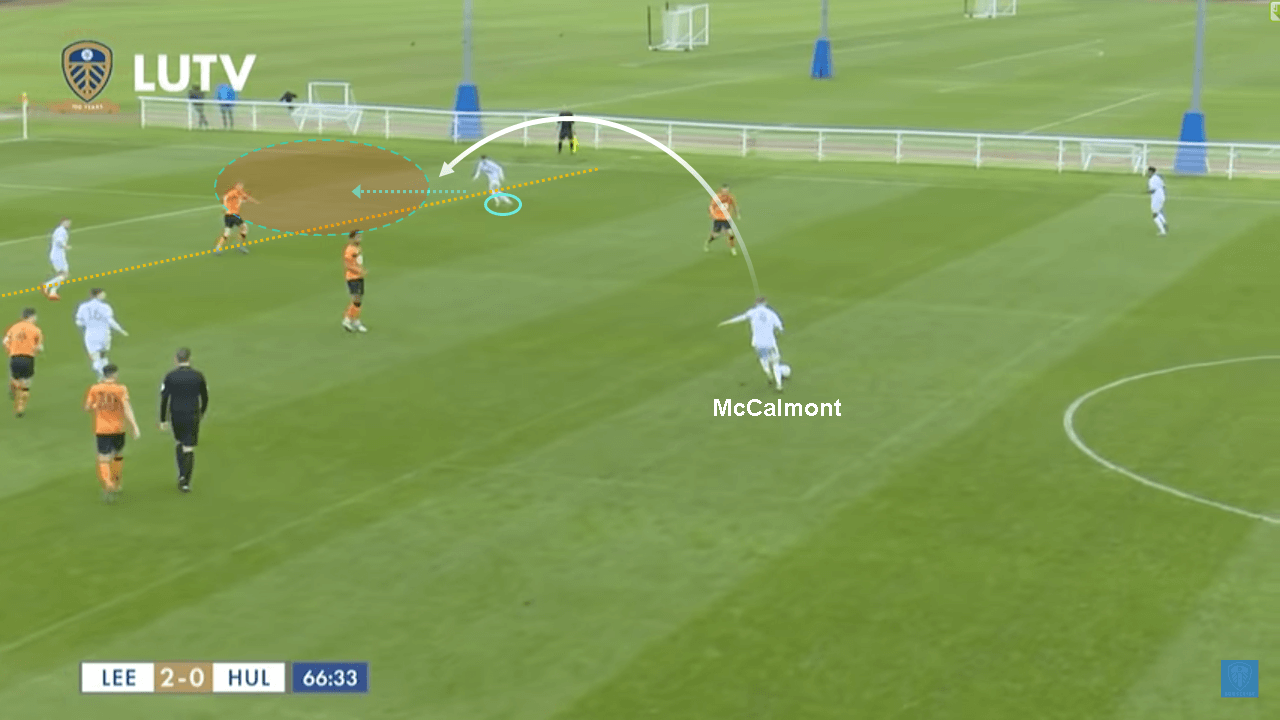
McCalmont has an innate understanding of time and space and demonstrates excellent composure on the ball. His technique to receive the ball shows a strong foundation and fundamentals from his youth development. He is able to use his body position effectively to shield the ball out of surrounding pressure and always looks to receive on the farthest foot which opens up the pitch for him. In two instances here in the youth league, we see how he receives the ball positioning himself between the ball and the nearest threat, thereby protecting the ball and taking it out of an overload.
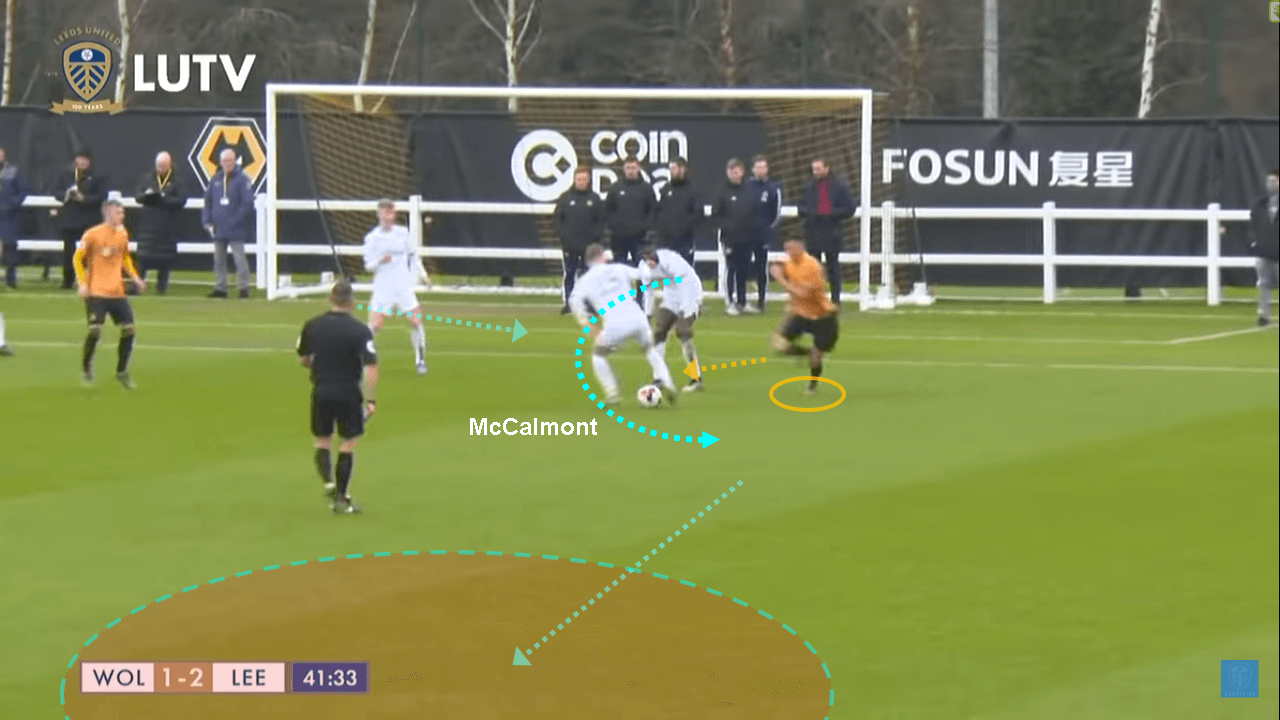
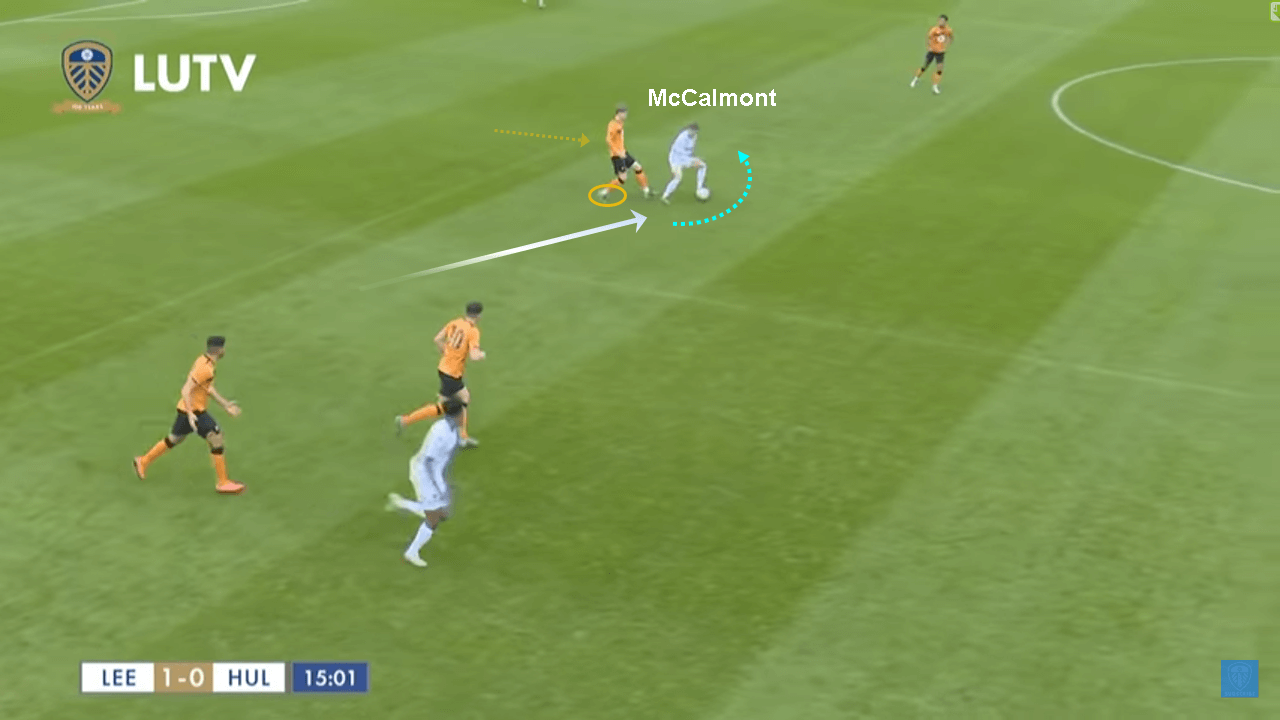
Aside from the long ball, McCalmont averages 34.8 accurate passes every 90 min with an 84% pass accuracy. He is able to break lines of pressure after picking up the ball from the defence with disguised passes into the advanced players up the pitch. He has a commendable first touch and receives the ball 27 times every 90 min.
His eye for penetration is reflected in his stats and offers a formidable threat to his opposition. When he finds time and space, he constantly seeks the through pass and has a 50% success rate with his through balls. 37% of his passes are forward passes making 7.6 passes every 90 min into the final third with a 64% pass accuracy, and 0.75 passes every 90 min into the box with 83% accuracy. Despite being a deep-lying playmaker, he has a mean xA of 0.32.
Offensively, he carries an average xG of 0.063. Higher up the pitch into the opposition half, in situations where he cannot find a viable passing option, he initiates a quick give-and-go with surrounding teammates and darts forward into advanced positions. In this goal that he scored against Hull City U23 in a 5-0 win, we see how he engages a wall-passer outside the 18-yard box and catches the defenders by surprise. He manages to finish the move cleanly and score the goal in this situation.
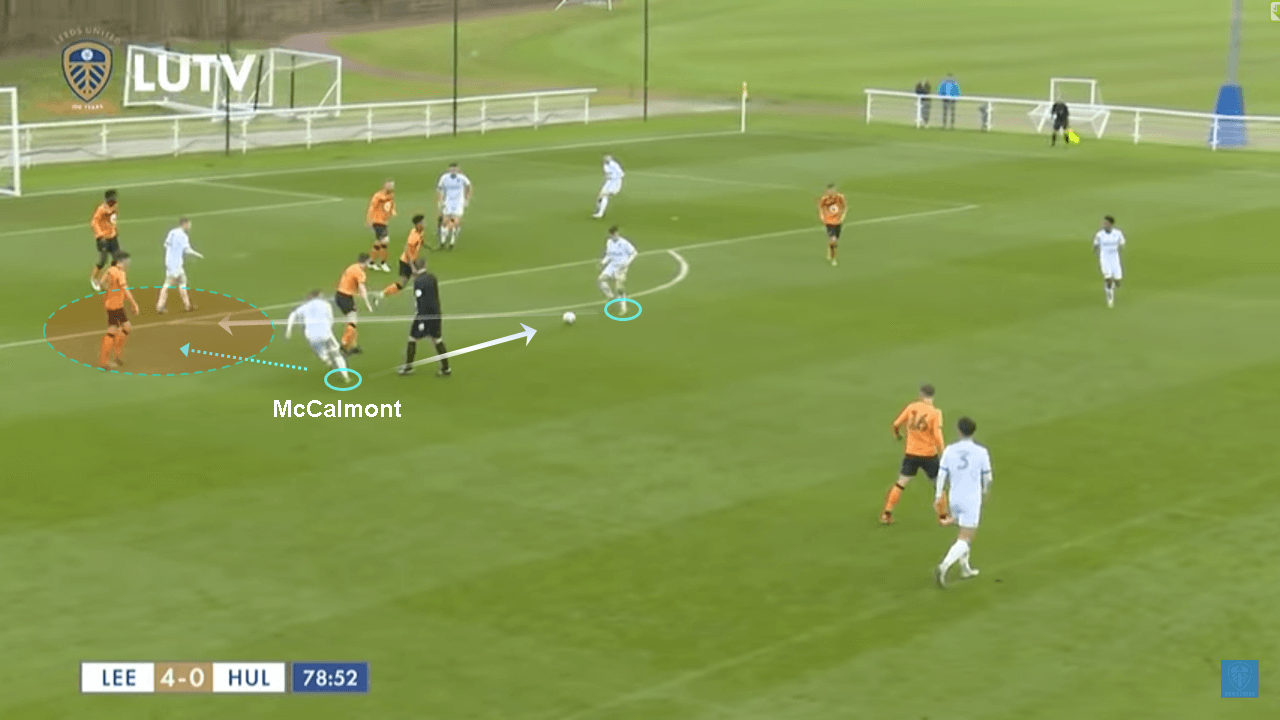
Actions off the ball
According to wyscout, McCalmont averages 45.6 successful actions every 90 min with 66% successful actions of his total actions. However, what the stats don’t highlight are his actions off the ball that sets him apart from other youth players. The reason why he is tailor-made for the holding midfield role is his tendency to drop into the hole in front of his defenders asking for the ball. In each attacking build-up from the back, we notice his habitual move to drop deeper asking for a pass.
Here we see him checking his shoulders and coming deep asking for the ball from a fullback. He receives the pass and plays it back to the centre half to circulate possession, demonstrating a textbook move from a holding midfielder.
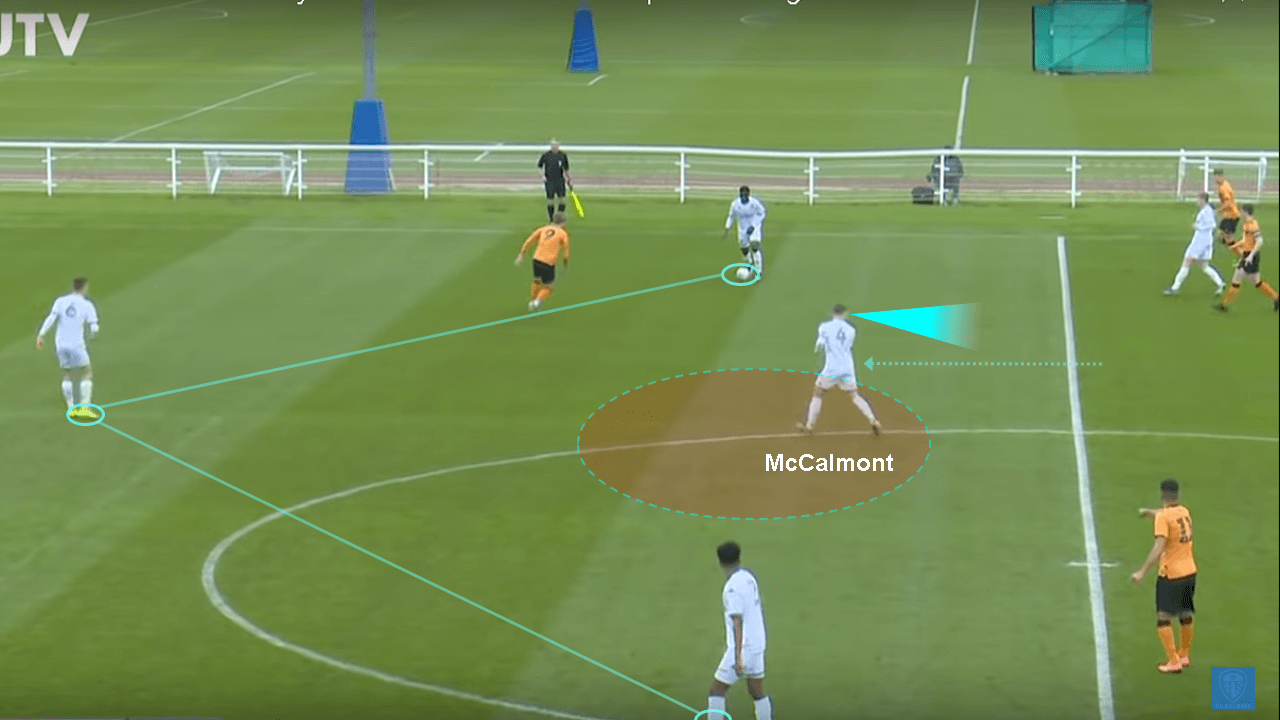
In another instance we see him starting off in an advanced position when his defenders are in possession of the ball, but he rotates with his fellow midfielder to drift back into the hole and build-up with his defenders alongside. This rotation is typical of Bielsa’s pattern that is often seen with the first team utilising Philips and Mateusz Klich when either one of them is being man-marked.
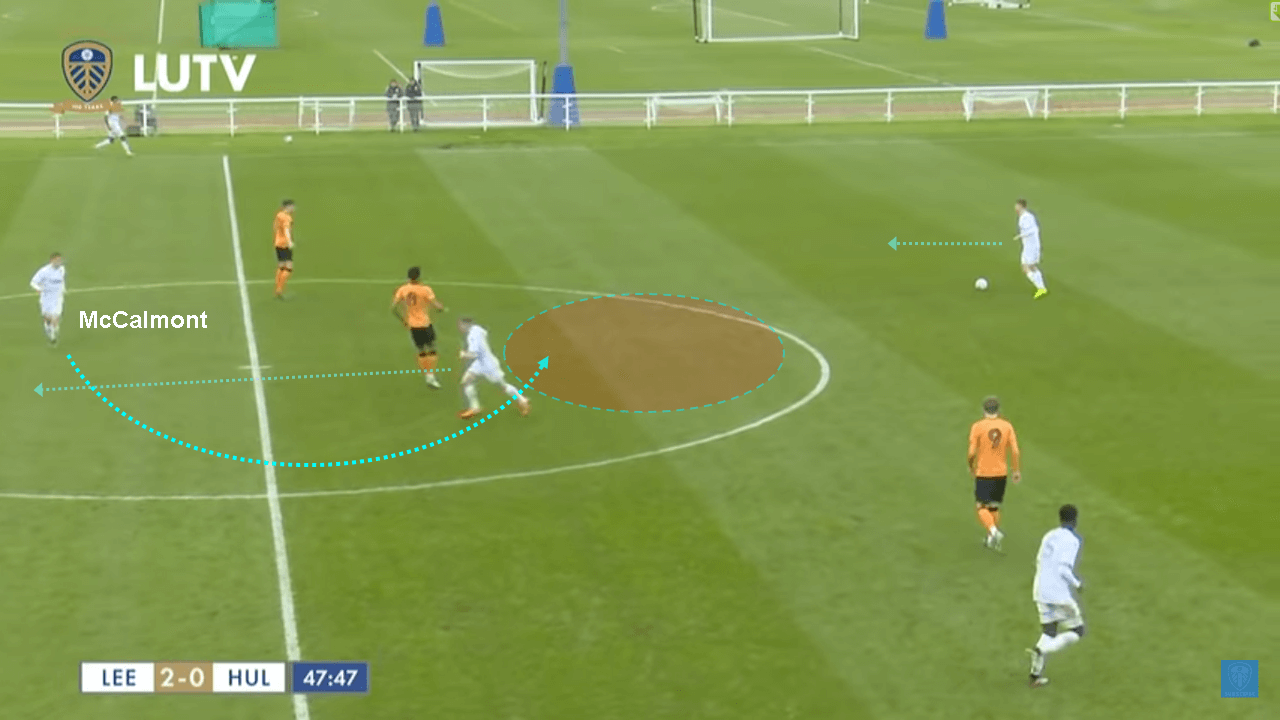
The reason why he is so effective as a deep-lying playmaker is due to his natural ability to make space for himself to receive the ball. While his defenders dribble out from the back in the build-up, he first moves forward in the same direction drawing markers with him and stealthily changes direction to drop and make space for himself. We see how he starts off high, close to the halfway mark, while the centre half dribbles out forcing the opposition forwards to jockey back for cover. He suddenly moves towards the centre half dismarking himself and making himself available for a pass.
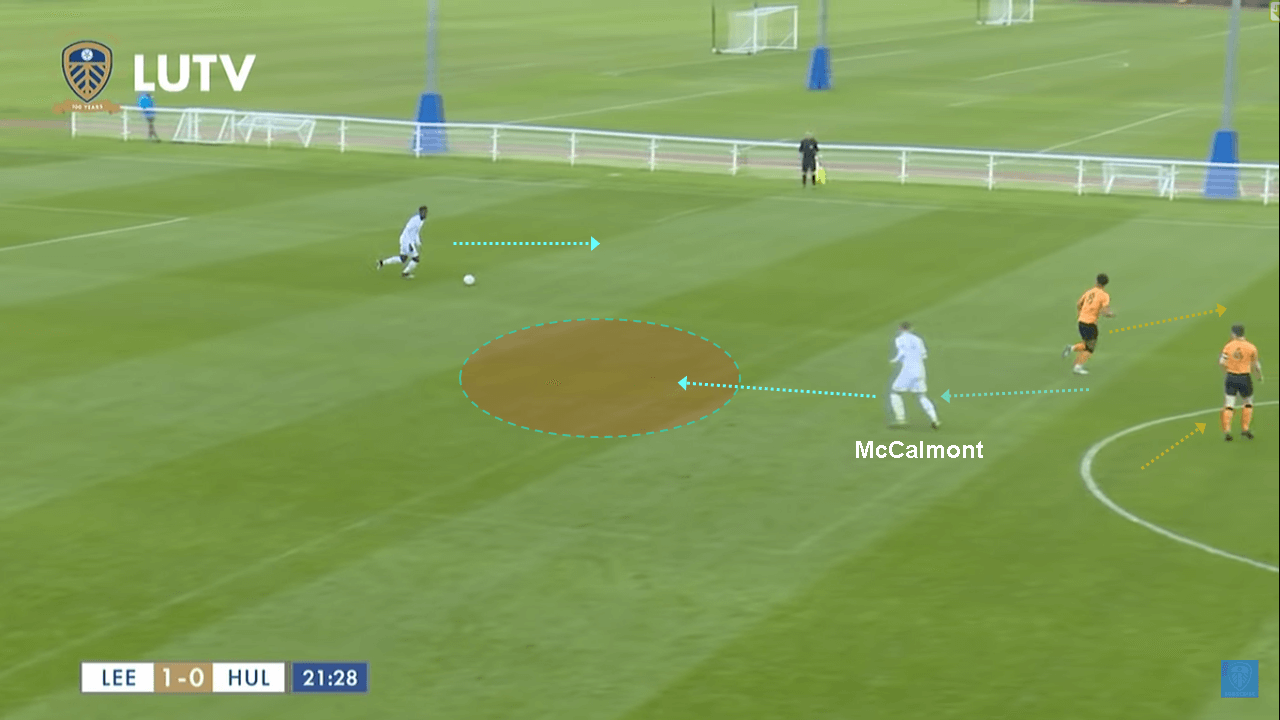
In another situation we see him performing a similar action. As the defence builds up on the right side with the fullback advancing to receive the ball, the opposition drops back and shuffles across. McCalmont checks his shoulder and quickly moves against the flow of the game to make space for himself. This is what makes him an effective playmaker from deep positions. His composure on the ball enables him to receive even when pressured and make the right decisions. With the U23s he often dictates the rhythm of the game from behind.
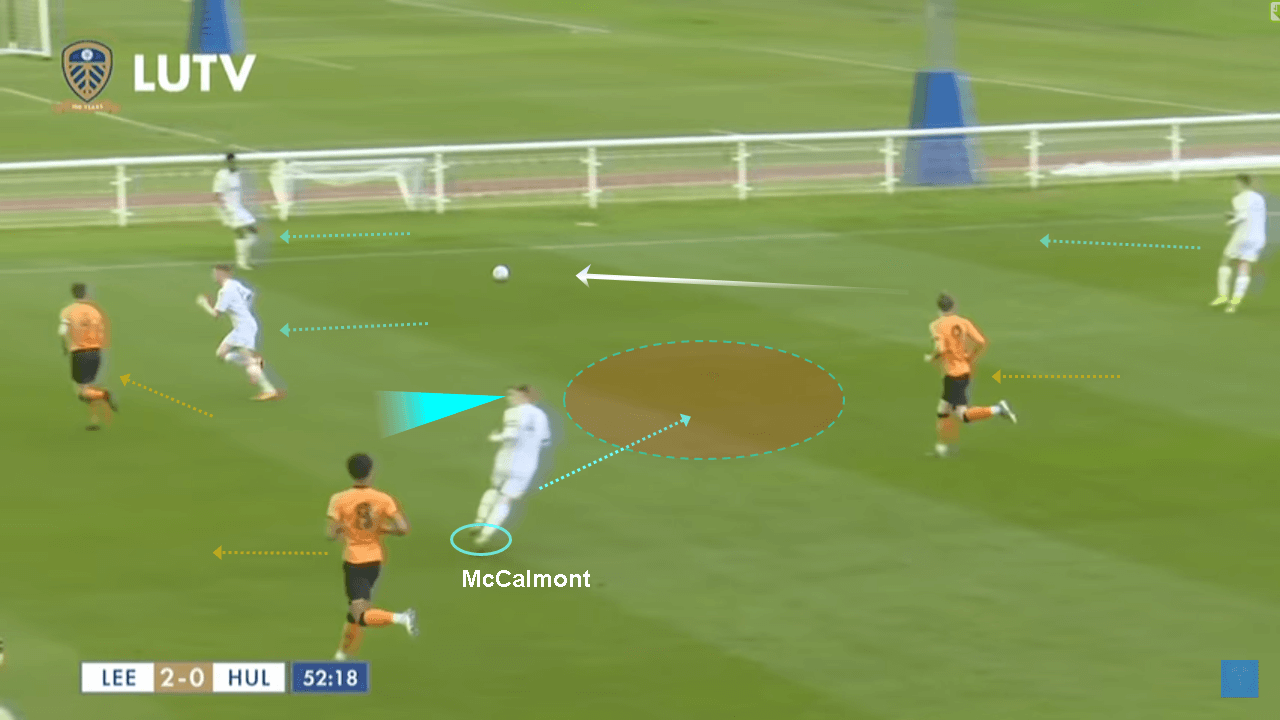
Defensive transitions
We have already seen McCalmont’s game intelligence in attacking organisation. He demonstrates similar intelligence in defensive transitions by quickly predicting the threat during a counter. McCalmont averages 4.4 interceptions per 90 min. He wins 56% of the 5.7 defensive duels that he averages. Due to his shorter height, we can see that he finds himself at a disadvantage in aerial duels, winning only 36% of aerial duels. What he lacks in physicality, he makes up with the intelligent reading of the game.
In this graphic, we see a defensive transition against Hull City U23, where the Leeds U23s are caught on the counter. McCalmont recognises that a fellow teammate is closing down the player in possession, and finds time to look around for what passing options the opposition might have. In this situation, he correctly identifies and tracks the run of a striker and makes a successful interception beating the opposition forward to the ball.
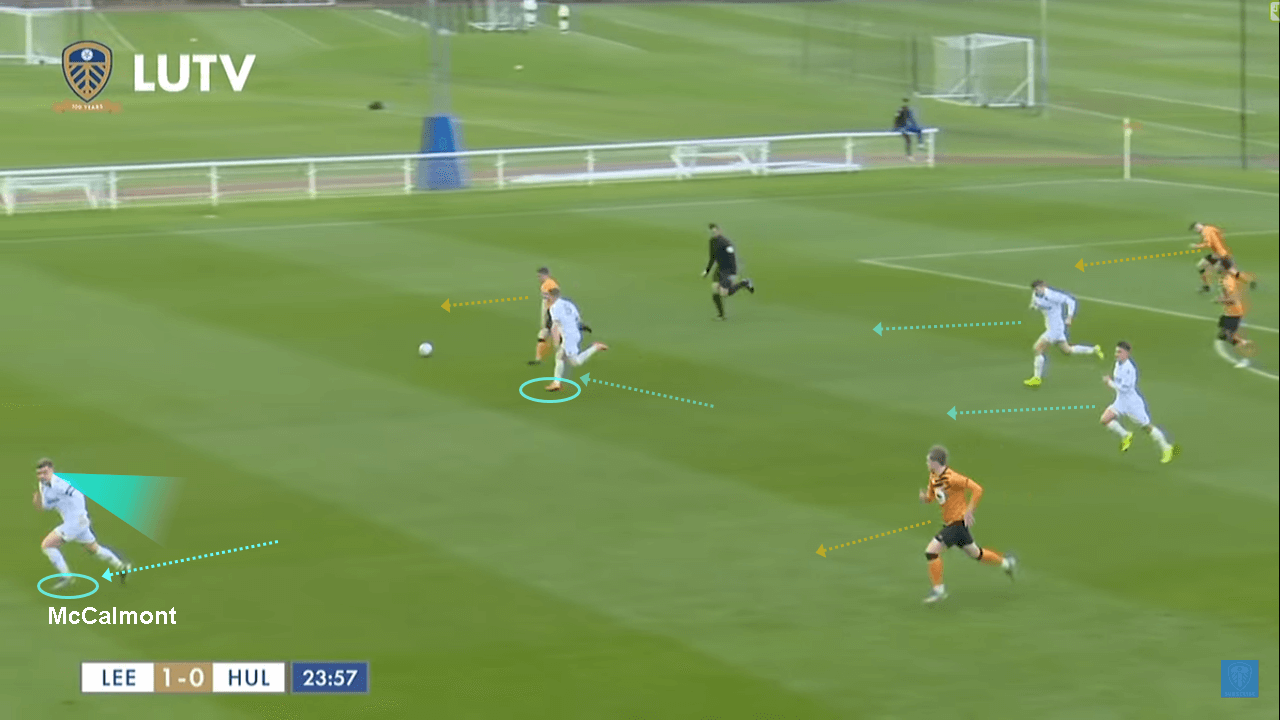
He averages 5.7 recoveries every game with 40% of them in the opposition half. A drawback that we notice is his hesitancy in putting in aggressive tackles immediately upon turnovers. We clearly see that he is less aggressive than Kalvin Phillips and makes far less sliding tackles, preferring to cover than to press and relying on teammates to close down immediate threats so that he can focus on the next move. We noticed this lack of confidence in defensive transitions in his first team debut against Salford City.
Reading the game and recognising overloads
His constant visual exploratory behaviour lends him a big advantage in reading the game. One of his strongest qualities that makes him a precocious talent is his ability to think defence during attack and vice-versa.
In this instance we see the Leeds U23s being heavily pressured in a situation of overload on the left side of the pitch. Most other players would recognise this situation as a moment to drop to recycle possession, absorbing the pressure first and then think of attacking forward. But McCalmont cleverly leaves his teammates in the vicinity of the ball to deal with the surrounding pressure and finds the time to look for an option on the other side of the pitch. He knows that his position makes him an immediate viable passing option his teammate under pressure, so when he receives the pass he has already planned his next move which is a quick first touch letting the ball run across his body and switching the direction of play to the other side where there is an underload.
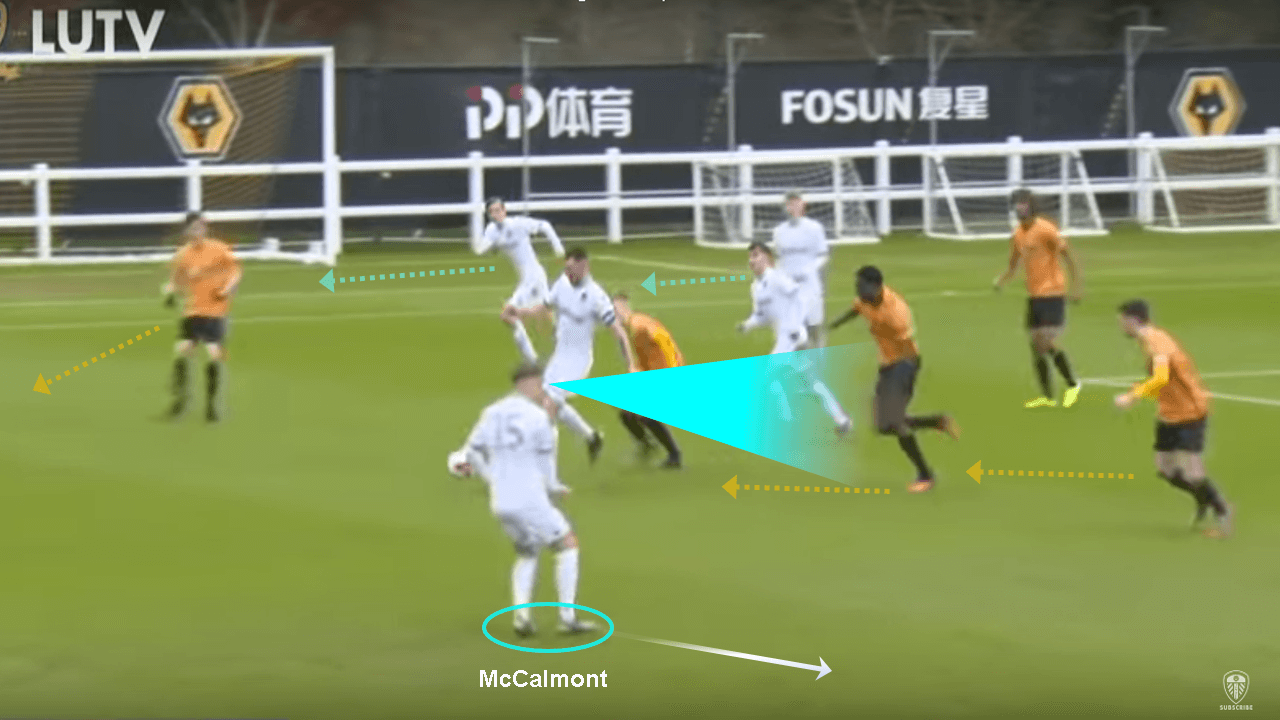
In another situation, we see an overload in the opposition half leading to the ball needing to be played back. McCalmont quickly recognises this overload and receives the ball across his body towards his own goal to play it back to his defence who can then switch the play to the other side.
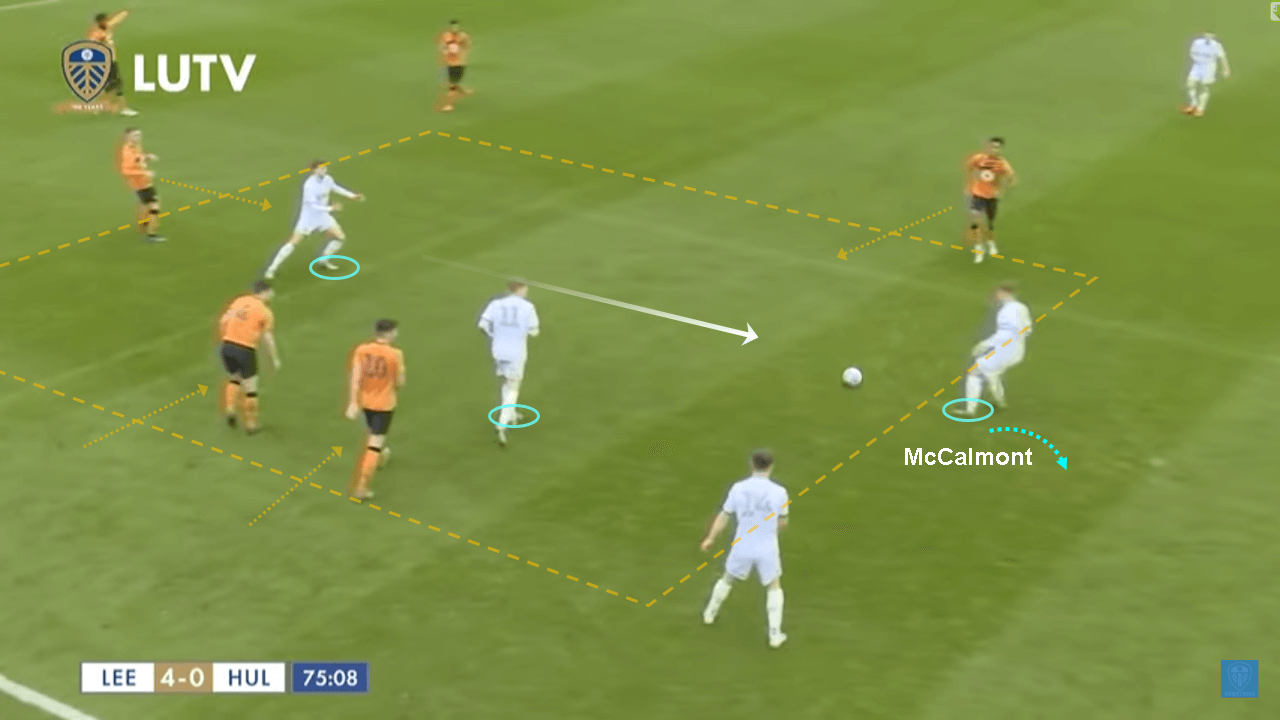
Senior team experience
McCalmont has played two games with the first team, both in the EFL Cup. His debut was against Salford City. He was brought on as a substitute for the final 20 minutes of a game that Leeds was winning comfortably. He was deployed as a second pivot alongside Phillips. Perhaps Bielsa felt that the best experience for the protégé would be sharing game time and space alongside the master in the same position. He looked nervous taking time to find his groove while playing alongside the heavyweights in the senior team. He was constantly looking to pass to Phillips or Klich, suddenly perceiving the game at a much faster tempo than what he is used to.
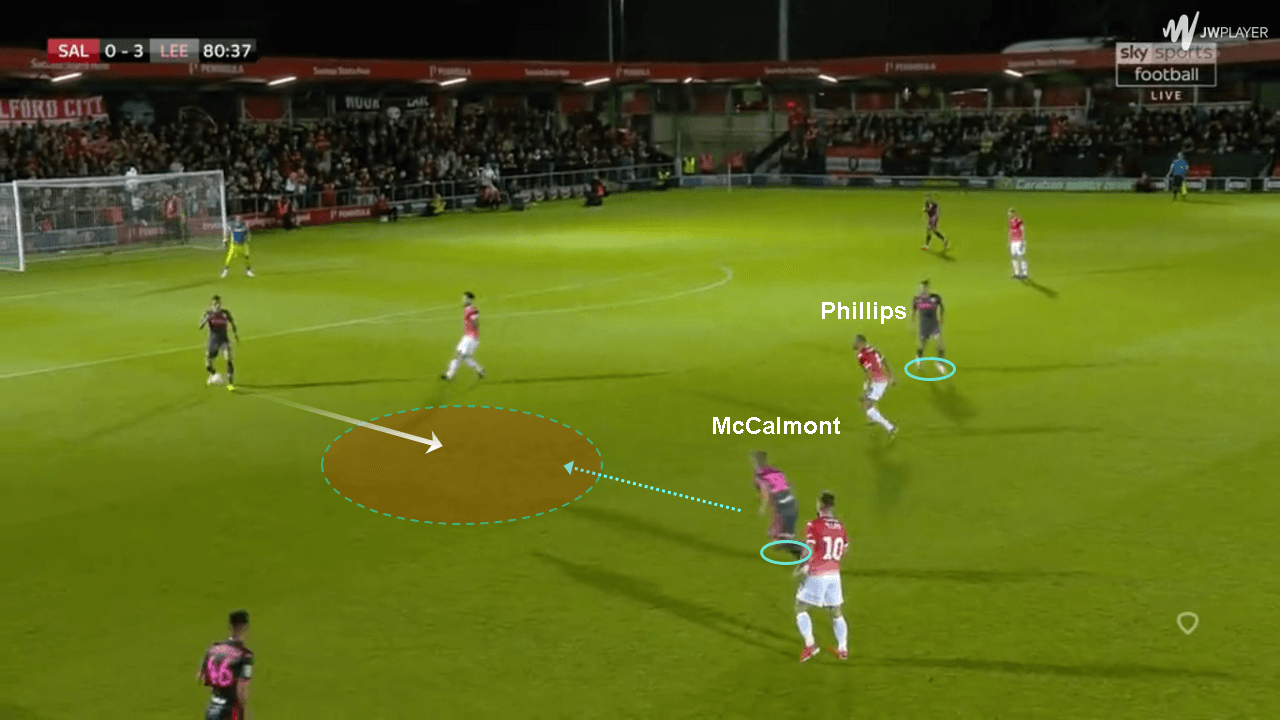
His second opportunity came at Elland Road finally with the cup fixture against Stoke City. He played the first half as the solo regista in a 3-1-4-2 formation. In this game, Phillips played behind him as the libero in a three-man defence. It was a step-up from his previous challenge but having Phillips and Gaetano Berardi behind him gave him the confidence to take risks. He did well playing 29 passes with a 96% accuracy and three accurate out of three long balls. Defensively, he only won one of four ground duels and not a single aerial duel. He also didn’t attempt any dribbles. He was taken off at half time in a triple substitution by Bielsa as the home side were trailing 0-2.
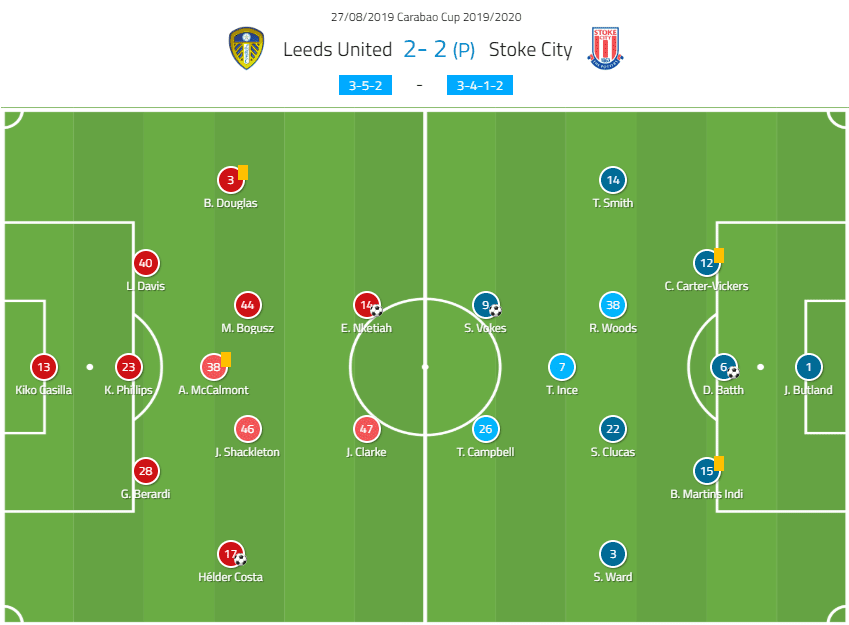
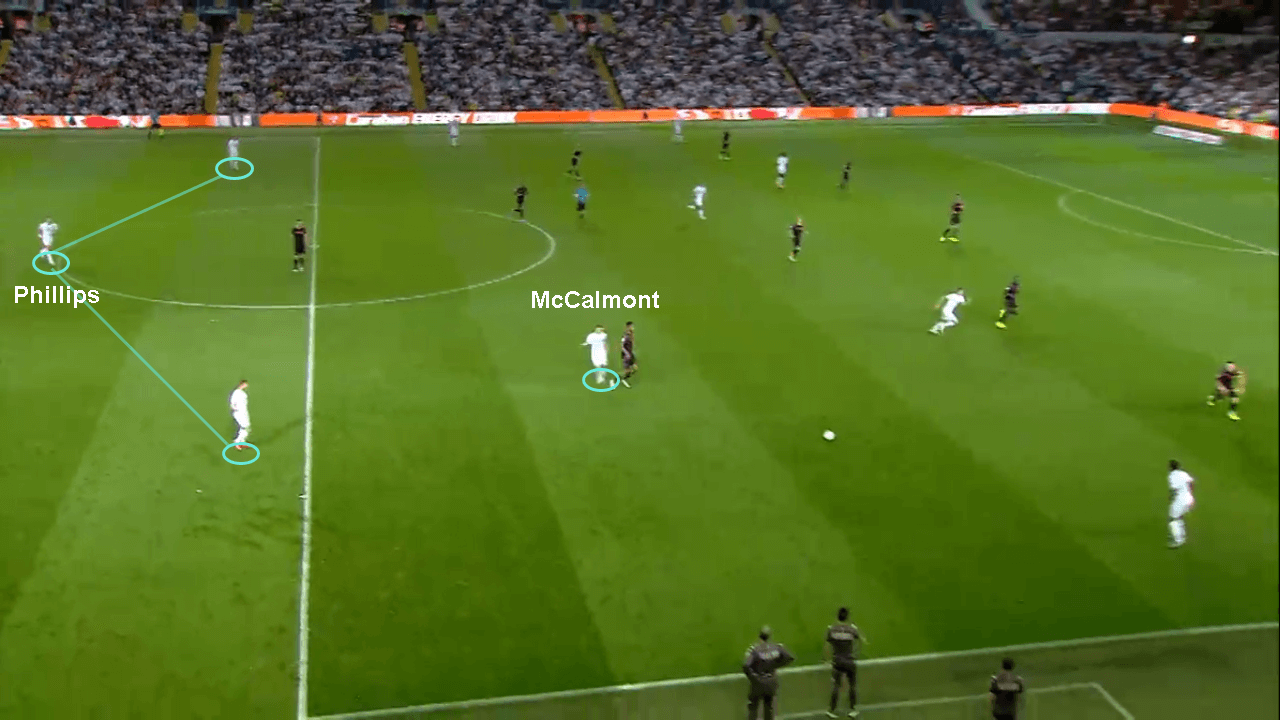
Although he hasn’t had enough first team football experience, we can see that he is on a steep learning curve. His senior debuts lent him a highly successful PDL run and subsequent national team selection. When the tempo is higher and the game is more aggressive, as in the Championship, he tends to make the safe passes to experienced senior players and takes fewer risks. He needs to work on making quicker aggressive defensive interventions and dribble more often out of trouble.
We find him seeking a lot of support from players like Klich with tremendous experience in the midfield, Phillips who is a role model for his position and Stuart Dallas who also plays for Northern Ireland. Currently, in Phillips’ absence, we can see him periodically filling in the deep-lying playmaker role which Bielsa is missing, provided he has players around him which he can depend upon. If we compare the average positions of players with and without Phillips, the Yorkshire Pirlo’s void is evidently palpable. McCalmont may finally find the stage to prove himself in these circumstances if he is utilised carefully.
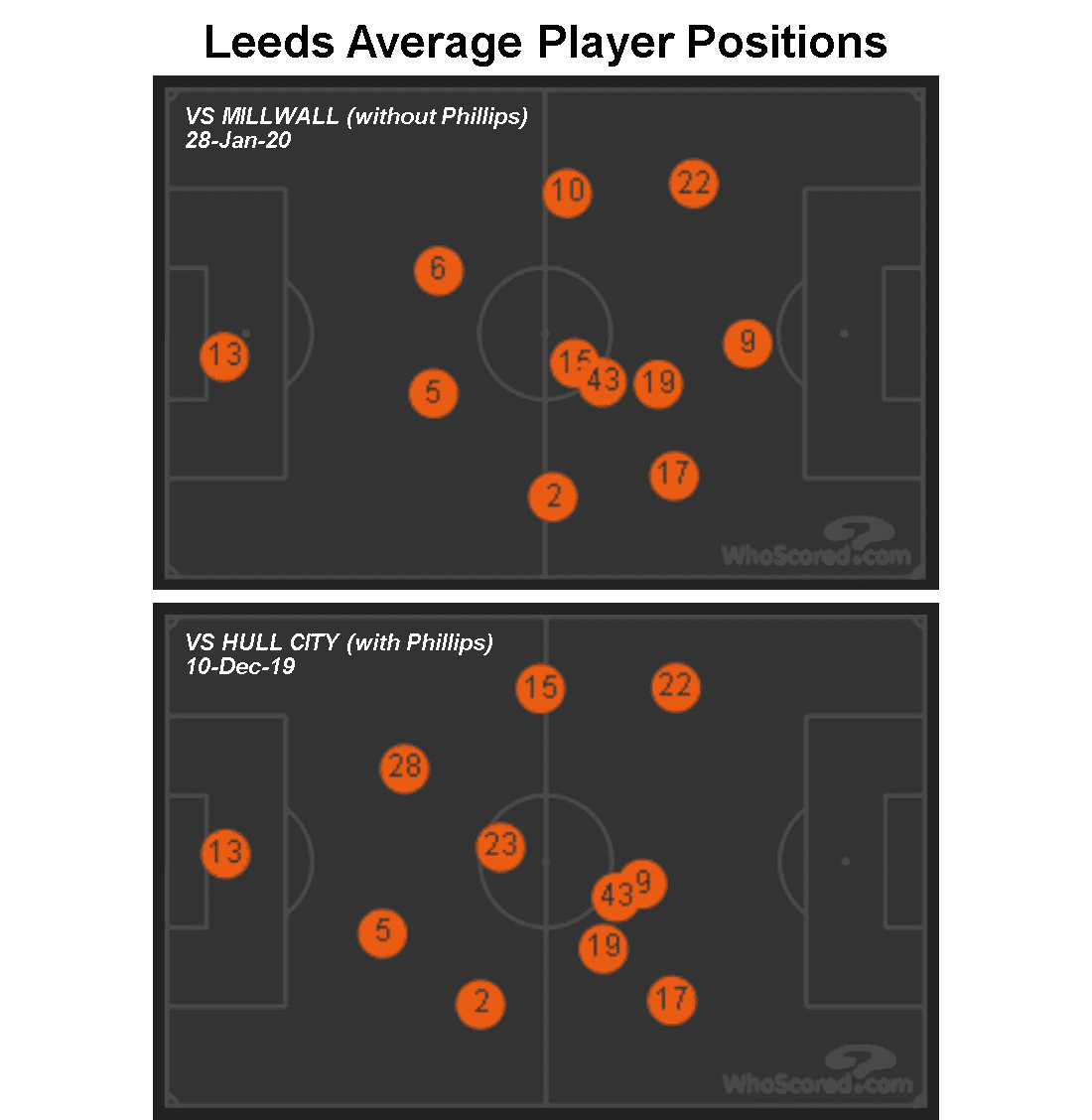
Conclusion
Alfie McCalmont is still a teenager and will probably take a while before he can deftly fill Phillips’ shoes in the deep-lying playmaker position. But Phillips’ ban is an obvious setback to Bielsa and McCalmont has a golden opportunity to prove himself. His game intelligence and technical abilities make him a promising talent with lots of potential if his development and transition into first team football is carefully guided.
Leeds have just acquired Ian Poveda, an attacking player on loan from Manchester City in this transfer window, but there is no news of them looking into the holding midfielder market yet. It is in all likelihood that Leeds United place a lot of trust in their academy star McCalmont, and believe in his potential. He will turn 20 in March and will soon be expected to rumble with the adults. If he works on his physicality and confidence, he can undoubtedly prove an indispensable asset to the Yorkshire side.




Comments